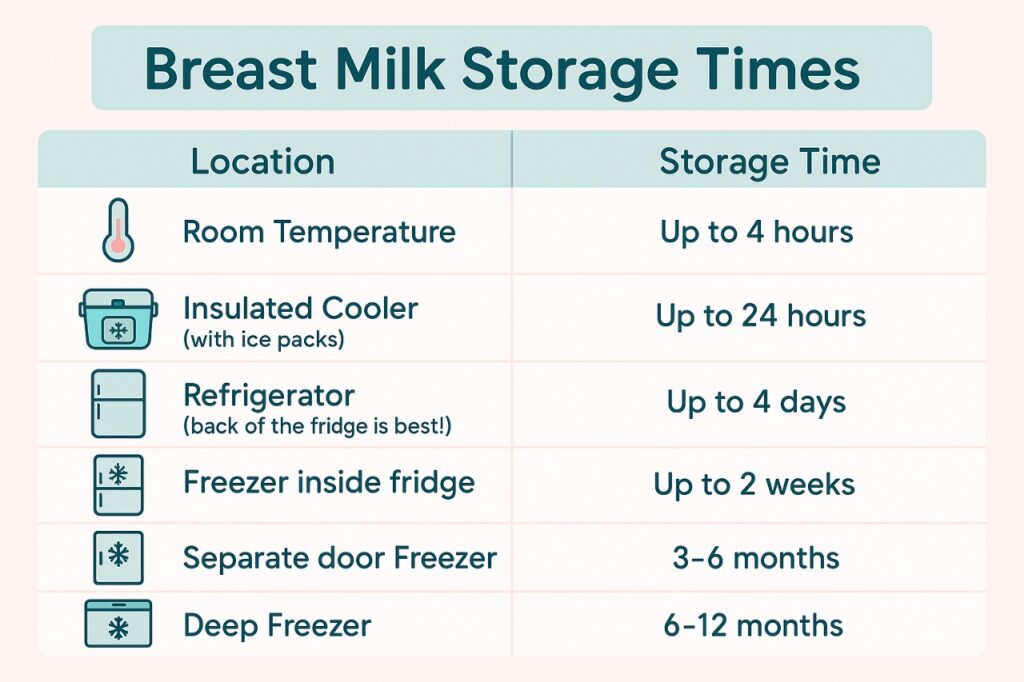For new moms across the U.S., one of the most common questions after pumping is — “How long can I keep breast milk safely?”
Proper storage ensures your milk remains rich in nutrients, safe for your baby, and waste-free. This guide breaks down how long breast milk lasts at room temperature, in the fridge, and in the freezer — plus a few practical tips many other websites don’t mention.
Storage Time Guide (Official CDC Recommendations):
According to the CDC (Centers for Disease Control and Prevention): https://www.cdc.gov/breastfeeding/breast-milk-preparation-and-storage/
-
Room temperature (77°F / 25°C or lower): Use within up to 4 hours.
Note: If the baby has already started drinking from the bottle, discard any leftover milk after 2 hours.
-
Refrigerator (40°F / 4°C or lower): Store for up to 4 days.
Note: Keep containers at the back of the fridge, not in the door (temperature fluctuates there).
-
Freezer (0°F / –18°C or colder): Quality is best within 6 months; safe up to 12 months if consistently frozen.
Note: Place milk deep inside the freezer, away from the door. Leave ½–1 inch headspace for expansion.
-
Thawed milk (after defrosting): Keep in the fridge for up to 24 hours.
Note: Never refreeze thawed milk.
Room Temperature Storage (Quick-Use Milk):
Freshly expressed milk can stay at room temperature (77°F / 25°C or cooler) for up to 4 hours.
If you’re traveling or at work, keep milk in an insulated cooler bag with ice packs for up to 24 hours.
After the baby has started feeding, discard any leftover milk after 2 hours — bacteria multiply quickly at room temperature.
Pro tip: Always chill your milk immediately if you don’t plan to feed within a few hours.
Refrigerator Storage (Short-Term Use):
When stored in a refrigerator at or below 40°F (4°C), breast milk can last up to 4 days.
Place it at the back of the fridge, where the temperature remains most stable — avoid the door compartment.
If you haven’t used the milk by the fourth day, move it to the freezer immediately.
Also, avoid adding warm milk to an already chilled bottle — it raises the temperature and can spoil the batch.
Freezer Storage (Long-Term Preservation):
Freezing milk is the best way to store it long term. At 0°F (-18°C) or colder, it stays fresh for up to 12 months, though quality is highest within 6 months.
Store containers away from the door to avoid temperature fluctuations.
Leave at least ½ inch of space in glass bottles or bags to allow milk to expand during freezing.
Once thawed, do not refreeze — use within 24 hours for best results.
Thawing and Reheating Milk:
The safest method is to move milk from freezer to fridge and let it thaw slowly overnight.
For quicker thawing, place the sealed container in a bowl of warm water (not boiling).
Avoid microwaving breast milk — it destroys nutrients and creates hot spots that can burn your baby’s mouth.
Cleaning, Labeling & Handling Tips:
- Always wash hands before expressing or handling milk.
- Use food-grade glass or BPA-free plastic containers with tight lids.
- Clearly label each bottle with date and time.
- Do not shake milk roughly; instead, swirl gently to mix separated fat.
- Discard milk that smells sour or has curdled texture.
- Avoid reusing storage bags — they can trap bacteria after one use.
Common Mistakes to Avoid:
- Keeping milk in the fridge door (temperature fluctuates).
- Mixing freshly pumped warm milk with cold milk.
- Refreezing thawed milk.
- Overheating in microwave.
- Not labeling storage dates properly.
Following these small details prevents spoilage, contamination, and nutrient loss.
FAQ:
Q: How long does breast milk last after thawing?
A: Use within 24 hours if kept refrigerated.
Q: Can I combine milk pumped at different times?
A: Only if both are at the same temperature — cool the fresh milk first.
Q: Why does frozen milk sometimes look yellow or blue?
A: That’s normal — fat separation and light reflection change its appearance, not its quality.
Q: Can I reuse leftover milk after feeding?
A: No. Once baby has drunk from the bottle, discard leftovers after 2 hours.
Conclusion:
In summary, fresh milk = 4 hours room temp → 4 days fridge → 6 months freezer.
Proper temperature, labeling, and hygiene keep every drop safe and nutritious.
Freezing extends shelf life without losing major nutrients — and using glass or BPA-free containers ensures purity and safety for your baby.
👉 For more detailed guidance on which containers work best for storage, read our internal expert comparison:
The Best Milk Storage Containers: Glass vs Plastic vs Metal (Ultimate USA Guide)



